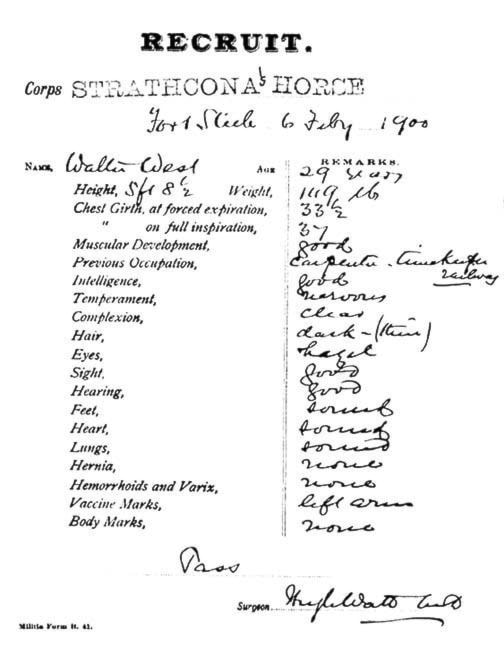Jim Cameron
They were, in many ways, a disparate lot, hailing from fields afar: Canada, the United States and Europe, all finding themselves in Cranbrook at the turn of the 20th century. Still, they all had something in common: they were, to a man, in the prime of their life and they were, to a man, ready to go to war.
By early 1900, the war in South Africa pitting the resident Boers against the British invaders was not going as well for England as might be expected. Though generally outnumbered, the Boer farmers and ranchers fought a type of small, independent "guerilla" warfare that seemed to handcuff the British troops, causing numerous losses with little success.
Men were needed, men who could both ride and shoot well and who could give back the Boers some of their own medicine. Lord Strathcona (Donald Alexander Smith) offered to personally finance and equip a mounted infantry regiment of Canadian volunteers. The force, to be known as the Strathcona Horse, was to include 504 men, 42 officers and 548 horses. He asked Superintendent Samuel B. Steele of the North West Mounted Police to serve as commanding officer. Steele promptly agreed and, following the insertion of ads in all Western Canadian newspapers, opened numerous recruiting stations from Manitoba to the Yukon, including Fort Steele.
Volunteers were required to sign up for six months (or one year, if required) and, according to Lt. Col. Steele, only the "the most respectable character to be taken, such as would pass into the NWMP."
As early as Jan. 18, 1900, a concert was held in Forrest Hall (later the Wentworth/Allan Hotel, now the 9th Ave. connector) to raise money for South African volunteers from the city. Although the event was hastily prepared it was a great success with speeches and entertainment given to a crowded and generous house. Towards the end of the show, in true English music hall fashion, Miss Magee sang the patriotic "Pay, Pay, Pay" while the hat was passed, raising $192 (over $5,000 today).
A paper circulated throughout the town exploited the local patriotic fervor to secure signatures for the yet-to-be-formed mounted infantry. It comprised 69 names, many the pillars of the community and almost as many of whom did not make it to the recruiting station a few weeks later.
In all, 40 men were selected, over one-half of whom were from Cranbrook. There were already others from town on their way to South Africa and there would be more to follow, but this group made up the local Strathcona Horse, Company "C" volunteers.
Required to report to Fort Steele at 12 noon on Feb. 8, just a day or two following their enlistment, what had been little more than talk suddenly became an undeniable rush of reality.
The residents of Cranbrook, eager to support the men, were forced to cancel plans for a public banquet and instead hold an improvised smoker at Forrest Hall. Once again the building was packed and the evening filled with patriotic speeches and songs from a community who, according to the Herald newspaper, "regrets their departure but glories in the patriotic courage" of the men who left homes, families and friends, who left jobs as ranchers, miners, railway workers, and clerks to travel halfway around the world to fight an unknown foe in an unknown land.
Saturday, Feb. 10, 1900, was a memorable day for the citizens of Cranbrook and for the men of the Strathcona Horse. Forty strong, under the command of local recruiting officer Captain Edmund Parker, they arrived in town at 11 p.m. accompanied by a band and a large group of citizens from Fort Steele. The contingent marched to the CPR station to board the train for Ottawa and then on to the fields of South Africa.
The volunteers stood in line on the platform while photographer Prest took three views. The boys were then given one hour to attend to last minute business and say their farewells. The photographs appear to be unaccounted for, but a newspaper description, in the purple prose of the moment, captures the event: "There were cheers for those departing and, as the train slowly pulled out, the vast concourse of people gathered at the station raised their voices in one prolonged cheer for the brave boys who had said goodbye to home and friends and turned their faces eastward as soldiers of the Queen. Amid the cheers there were many sobs and down the wrinkled cheeks of veterans as well as the smoother ones of the young, tear chased tear. In many instances a fervent hand clasp was the extent of the expression on either side. It was a sad occasion and yet the patriotism and loyalty of the people predominated. The tender feelings were sacrificed on the altar of duty and not one of the brave boys regretted enlisting at the trying moment when goodbye was said. It was about two o'clock when the order was given to board the cars and join the fifty-six-strong West Kootenay contingent. The long station platform and grounds were covered with a great mass of humanity. The engine gave a long, shrill warning whistle and the command, 'all aboard' passed down the line ... The band played, the crowd yelled and as long as the train could be seen, just so long were the boys hanging out of the windows waving farewell to dear old Cranbrook and their friends."
Next week: Life and Death in the Transvaal.
